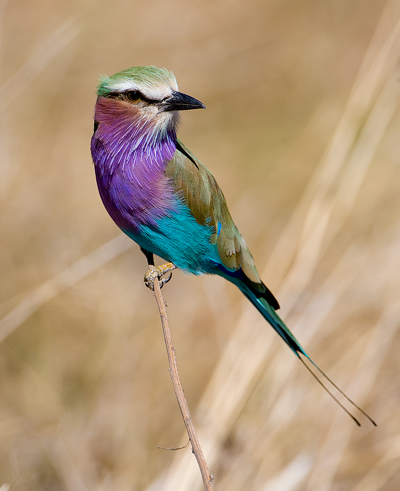upant English Name: Lilac-Breasted Roller
English Name: Lilac-Breasted Roller
Afrikaans Name: Gewone Troupant
Latin Name: Coracias caudatus
Setswana Name: Letlêrêtlêrê
Zulu Name: iFefe
German Name: Gabelracke
Portuguese Name: Rolieiro-de-peito-lils
French Name: Rollier longs brins
Dutch Name: Vorkstaartscharrelaar
The Lilac-breasted Roller is one of the most gorgeous birds on the planet, with colours reminiscent of a unicorn's regurgitation. It has a Roberts number of 447 and you will find a full description of the bird on page 169 and also a picture of the Lilac-breasted Roller on page 192.
A bit about the Roller from this website:
The washed green head is large, the neck is short, the greenish yellow legs are rather short and the feet are small. The beak is arched and hooked-tipped. The tail is narrow and of medium length. The shoulder of the wing, outer webs of the flight feathers and the rump are all violet. The base of the primaries and their coverts are pale greenish blue and the outer tail feathers are elongated and blackish. The chin is white, shading to rich lilac of the breast. The underparts are greenish blue. The bill is black and the eyes are brown.The sexes are alike in colouration.
Rollers get their name from their impressive courtship flight, a fast, shallow dive from considerable elevation with a rolling or fast rocking motion, accompanied by loud raucous calls. Its flight display shows the bird flying upwards 10 metres, and then falling with closed wings, gaining in speed by flapping. Flying very fast, it rolls to the right and left four or five times in a couple of seconds, and it sweeps again with closed wings, losing speed and repeats the roll.
Their call is a loud harsh squawk ('zaaak'). They are partly migratory, but in some areas they are sedentary. They are territorial, also defending temporary small feeding territories. They drive off many species from near their nest hole, even after breeding.
Reproduction
Lilac-breasted Roller performs a wonderful courtship flight, with fast and shallow dive from very high elevation, with rolling or fast rocking motion. It actually breeds “on the wing”. All rollers appear to be monogamous and highly territorial.
The Lilac-breasted Roller nests in natural cavities in trees, or in termite hills. It may use woodpecker’s and kingfisher’s holes. The nest is unlined. Female lays two to four white eggs. Incubation lasts about 22 to 24 days, by both parents, who are extremely aggressive in defense of their nest, taking on raptors and other birds. At nineteen days the chicks are fully feathered and grayish brown.
Habitat
Lilac Breasted Rollers inhabit acacia country with well spaced trees, rolling bushy game lands, riverside areas and cultivated land, but they do not associate with human habitation.
Food
The Lilac Breasted Roller feeds on grasshoppers, beetles, occasionally lizards, crabs, and small amphibians. Lilac-breasted Roller perches on dead trees to survey the area, searching for prey. It also preys on animals fleeing from bush fires. To feed, it swoops down from a high perch close to the prey, and as it eats the insect on the ground, or it returns to its perch to batter it before swallowing it whole.
In Culture
In African lore, the Lilac-breasted roller is the bird of peace and reconciliation. The beautiful ‘bird of the sun’. The Lilac-breasted roller was often sacrificed by kings who were making peace. One of these little birds was taken and its throat was cut with a battle spear, which was thus purified of evil and sanctified with the blood of the ‘bird of the sun.’ The spear was ceremoniously broken by the two kings and buried in a hole and then the bird was buried on top of this spear and thus peace was made.
But why Troupant?
This is the story that I have heard on many a bird drive, but I can't seem to find any documentation to back it up. The reason the Roller is called a Troupant in Afrikaans is that it's a corruption of the word: Trouband, or in English: Wedding Ring.
The story goes that young men wanting to get married will harvest the sticky gum from the Leadwood tree (Combretum imberbe), for example. They will find an appropriate dead branch, where Roller's often sit, and will place a "bolletjie" or wad of this gum on the branch. When next a Roller sits on the branch his feet get stuck and he is effectively trapped. The man then catches the Roller. He will remove a stunning blue feather from the bird. This feather is then offered to the bride-to-be and is wrapped around her finger. The blue from the feather will stain her finger.
So, apparently, according to game ranger legend and tale, this is how the Lilac-Breasted Roller came to be called the Gewone Troupant in Afrikaans.
Do any of you have anyway of corroborating this story? Please post comments. It's a great story, but I'd like to know if its just a yarn or if it really is a cultural practice. How else would it get the name Troupant, unless it is somehow related to wedding ceremonies?
Some stunning pics by Callie De Wet:











4 comments for this post
Great post! did you ever find the answer to troupant wedding tradition? I'm trying to figure that out as well!
Ik ben zojuist ten huwelijk gevraagd door mijn Zuid Afrikaanse vriend. We hadden tijdens een wandel safari van onze gids het verhaal gehoord. Als een man vroeger geen geld had om een ring te kopen, dan vroeg hij zijn vriendin ten huwelijk met een veer van de troupand. De vogel mocht niet gedood worden. De veer zou later als pochet gedragen worden in de blouse van de man. Groet Monique Smits
Amazing Knowledge...Truely informative...Thank you...
Amazing hey? Surely Soo amazing